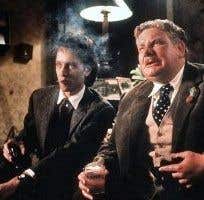'Would you like a drink?'
'Sherry.'
'Sherry.'
'Sherry?'
'Sherry.'
'Sherry.'
Perhaps not the most famous of the many quotable passages in Withnail & I (image of Richard E Grant and Richard Griffiths © Hand Made Films), but a personal favourite nonetheless. It is an exchange that my brother and I often act out if we meet for drinks somewhere that serves sherry, which indeed we did last Friday evening. Only having concluded the routine and ordered our Manzanilla did I learn the poignant news that Richard Griffiths, the actor who in the character of Uncle Monty uttered three of those five 'sherries', had died earlier the same day.
His performance in the film is justly revered, and remains a testament to great talent. Griffiths' physical bulk was animated with considerable nuance, and few actors could have imbued the character of this prissy, predatory homosexual with such pathos.
Part of Uncle Monty's redeeming charm is his bonhomie when it comes to eating and drinking – and his repertoire does not stop at aperitifs. Withnail comments, at a moment of high tension, 'I'll say one thing for Monty: he keeps a sensational cellar.' And so he does. In fact Monty's cellar is sensational not just for the quality of the wine, but for the impeccable attention to detail with which it was filled by the film's director.
All of the first growths appear on screen – all four of them, that is. The film was made in 1986, but set in 1969, before Mouton's promotion. Someone was alert enough to realise that Chelsea-dwelling, Rolls-driving, Harrow-educated Monty wouldn't dream of drinking a second growth, and Mouton's absence is a telling period detail. Not only that, we get the old straight-sided Haut-Brion bottle, indicating a pre-1958 vintage; the idea of broaching a decent claret before its tenth birthday would surely, too, be anathema.
As a final gesture of companionship before the film's close, Withnail offers his friend a bottle he 'confiscated' from Monty's cellar: 'fifty-three Margaux, best of the century!' I recently asked Château Margaux's commercial director Aurélien Valance whether this assessment held true. Sure enough, for him, the 1953 sits alongside 1900 as a pinnacle of the property. A sensational cellar indeed.
Cult films like this attract geeks, and here I put my hand up. The wine nerd takes delight in poring over such details, and derives solace from sensing the presence behind the lens of someone else in love with the same trivia. Each wine region accrues its own store of facts and myths as it becomes established, and these are grist to the mill of the geek.
Sometimes it does us good, however, to tear ourselves away from the comfort of the classics and experience a winemaking culture that has yet to accumulate this kind of intricate narrative.
I had a perfect opportunity last month to broaden my horizons. I was to judge at the annual Young Turkish Wines competition, organised by the Turkish Friends of Wine and Vine, an extremely well-organised association of amateur wine lovers who meet most months to taste and discuss wines from all over the world. Each March they collate and assess (blind) a broad range of local wines, mostly new releases; this year, professional judges were invited to join in for the first time.
Although Turkey's winemaking history is one of the longest, and its vineyard area is currently the fourth largest in the world, modern winemaking came to Turkey very recently. According to the Oxford Companion entry on Turkey, Kemal Atatürk, founder of modern Turkey, 'established the country's first winery for seven centuries in 1925 as part of his westernization programme'. At the dawn of the twenty-first century, still only a handful of commercial wineries existed. There has been a rapid proliferation since, but even so, according to the Turkish Friends, the 140-odd wines we judged over two days represented the vast majority of the country's output. Domestic consumption is a not-insignificant 75 million bottles – but this is a populous country, and that represents just one bottle per head per annum.
Here, then, was a rare chance to see a wine industry in nascent form. The set of wines we tasted was symbolic of the questions a young industry would naturally ask itself. Do we plant local or international varieties? Should we blend them? Should we pick early or late? What sort of part does oak play? Should we pursue a fresher (international) or more traditional (oxidative) style?
Not surprisingly, the wines varied a great deal, both in style and quality. Then again, you could say that about almost any region. The clear outcome, though, was that Turkey is now producing numerous wines of 'export' quality: wines free of technical flaws, with balance, clarity of expression, enjoyable flavours, and in some cases real individual personality. All the 'imported' judges – three MWs and two MSs – were impressed.
After the tasting, the organisers sprung a surprise on us. Would we address the assembled consumers and winemakers, with our thoughts on the tasting and some recommendations to the industry? Here is the advice I humbly proffered, none of it revolutionary, and much of it applicable beyond the borders of Turkey:
- The winemaker is not the creator of quality, but the guardian of quality. Learn from the recent change in countries such as Spain and Argentina, where overt winemaking effort has been scaled back, and the grapes are once again permitted to express themselves. Don't do more to the grapes (in terms of extraction, oak, and so on) than they can stand.
- Indigenous varieties are the key to differentiation. Turkey is blessed with many, clearly capable of good quality. No importer needs yet another Merlot.
- If you want to pursue non-Turkish varieties, choose them with care, and an open mind. The mainstream grapes (Cabernet, Merlot, Chardonnay) dominated the tasting, yet there were interesting entries from Malbec, Cabernet Franc, Viognier, even Pinot Meunier. Perhaps they could prove more suitable in some regions than the more obvious options.
- Be ruthless with your coopers. Good oak is in short supply, and those who shout loudest will get the best barrels. Poor-quality wood will instantly undo a year's good work in the vineyard.
- You must rotate your stock. Freshness is king for white wines and rosés. Cutting your margin to clear tiring vintages may dent your pride, and this year's P&L, but failing to do so will slowly drown your business in unsellable wine.
- Never give up the quest for quality. Other countries may have a head start, but on the basis of what I tasted, Turkey has much to offer.
WHITES
Chamlija, Istranca Chardonnay 2011 Trakya 16.5 Drink 2013-2015
Plenty of obvious oak, but it's good quality. Good grip and length – well done!
Kavaklidere, Côtes d'Avanos Narince/Chardonnay 2011 Cappadocia 16.5 Drink 2013-2015
Interesting spicy-peachy nose. Well-judged oak, good definition and length.
Likya, Arykanda Chardonnay 2012 Antalya 16 Drink 2013-2016
Good blend of fruit, oak, spice and lees. Harmonious and sensitively made Chardonnay.
Sevilen, Isabey Sauvignon Blanc 2012 Izmir 16 Drink 2013-2014
Subtle but quite complex nose. Very well balanced – well-made Sauvignon.
ROSÉS
Melen, Kalecik Karası Rosé 2012 Trakya 16 Drink 2013-2014
Interesting, fragrant, almost Pinot-like nose. Substantial, weighty, 'gourmand' palate.
Pamukkale, Meridies Rosé 2012 Denizli 16 Drink 2013
A blend of Öküzgözü and Cabernet Sauvignon.
Pure and delicate. Classy, mineral-saline style. Very Provençal.
REDS
Likya, Malbec 2012 Antalya 16.5 Drink 2014-2018
Impressive – if very young – inky, unformed nose. Lots of concentration and grip, yet beautifully poised.
Likya, Pinot Meunier 2012 Antalya 16.5 Drink 2013-2016
Delicate red fruit, pure, with good depth. Rich yet pure on the palate, with a lovely chewy finish. Slight alcohol at the end.
Pamukkale, Nodus Cabernet Sauvignon 2010 Denizli 16.5 Drink 2013-2017
Composed, classy black fruit. Sophisticated combination of fruit richness and mineral spice.
Vinkara, Mahzen Kalecik Karası 2010 Ankara 16.5 Drink 2013-2016
Good Pinot-style use of oak. Delicate, fragrant, but no lack of intensity. Delicious.
Yazgan, Mahra Boğazkere/Öküzgözü 2012 Anatolia 16.5 Drink 2013-2016
Richly ripe, yet retains vividness and freshness, with a lovely floral character. Concentrated, poised, yet very supple palate.
Disclosure – this is a wine that, on the back of the blind tasting, I shall be importing to the UK.
Doluca, Tuğra Öküzgözü 2010 Denizli 16 Drink 2013-2016
Slight reduction, but appealing red fruit aromas. Very vivid fruit on the palate – delicious balance.
Kayra, Versus Cabernet Franc 2010 Trakya 16 Drink 2013-2016
True, fragrant, discreet nose. Elegant, mid-weight, very clean, good expression.
Likya, Pinot Noir 2012 Antalya 16 Drink 2014-2017
Rich, dense, quite complex fruit aromas. Really juicy, expressive palate. Quite grippy tannin.
Sevilen, Majestik Öküzgözü 2012 Denizli 16 Drink 2013-2015
Pure, light, fresh, very appetising. Delicious, crunchy, Dolcetto-like style.
Urla, Cabernet Sauvignon 2011 Izmir 16 Drink 2013-2017
Pure, focused, beautifully ripe nose. Rich and poised on the palate, with spice on the finish. Alcohol a touch obvious?
Doluca, Tuğra Boğazkere 2010 Denizli 16 Drink 2014-2017
A little dominated by creamy notes, but good clean fruit. Young tannic wine with lots of potential.

